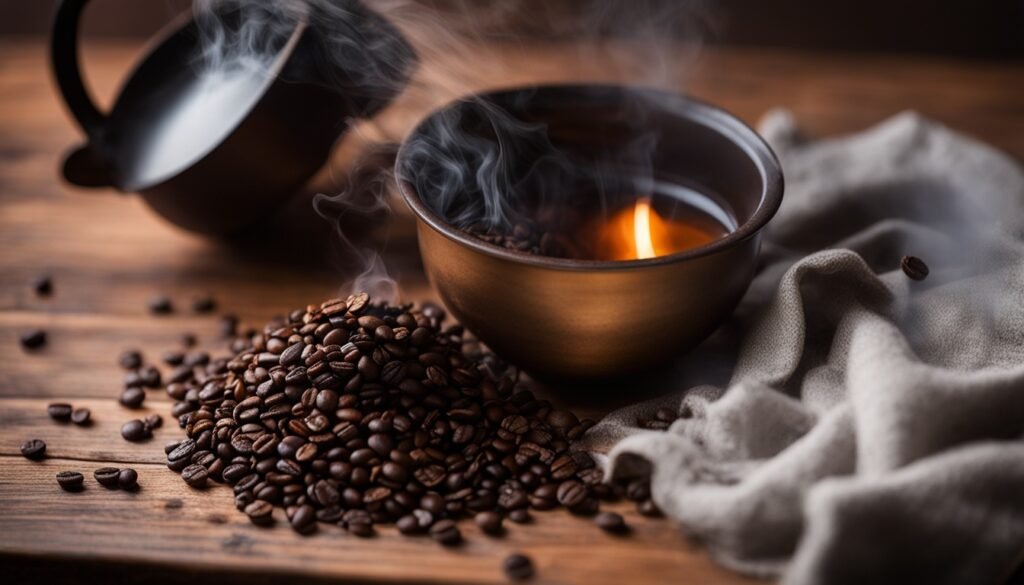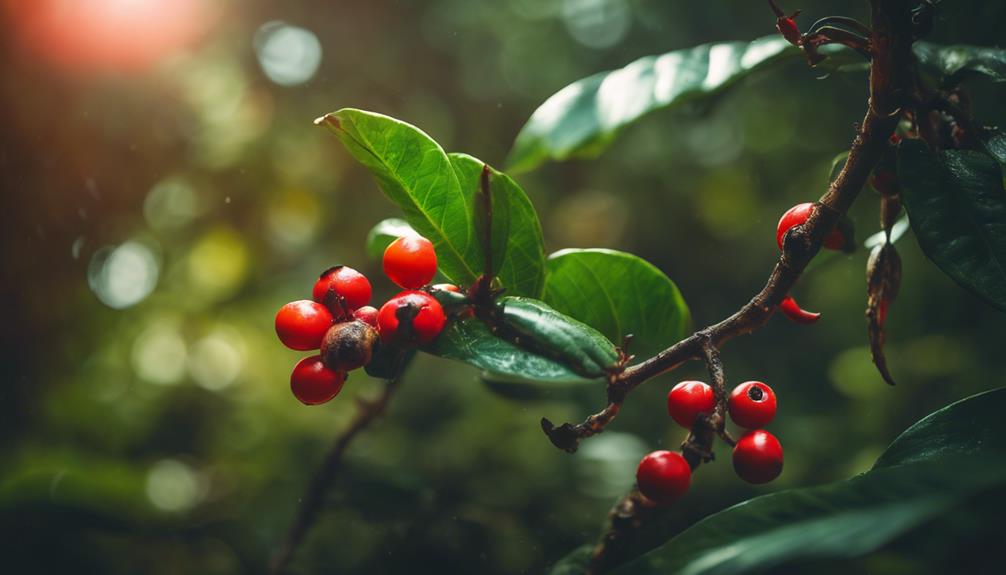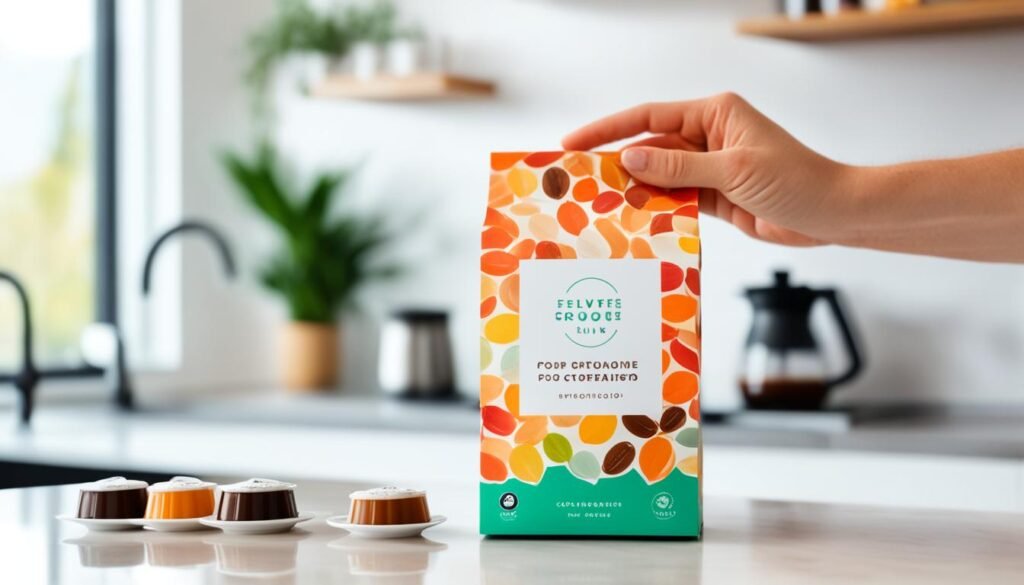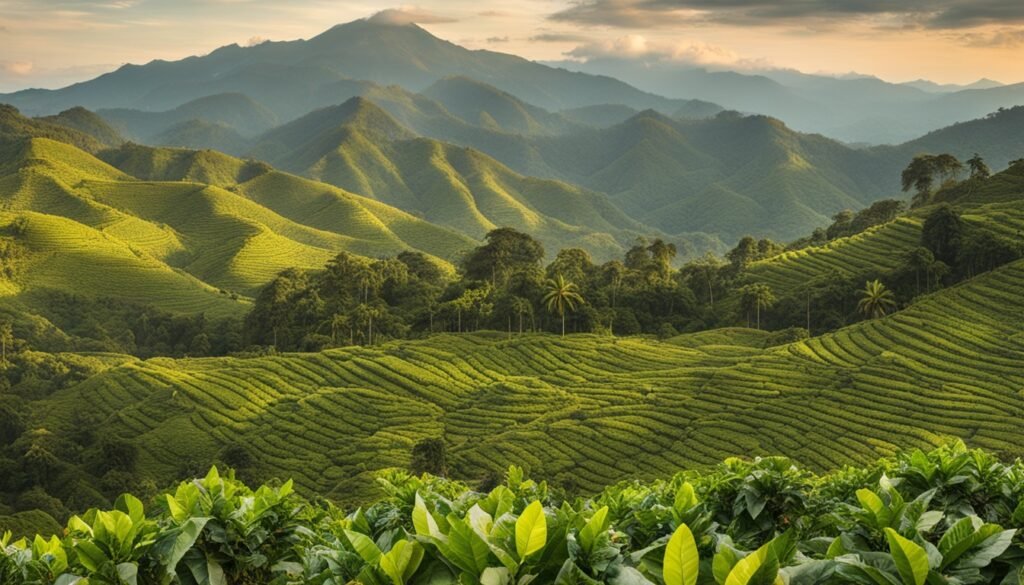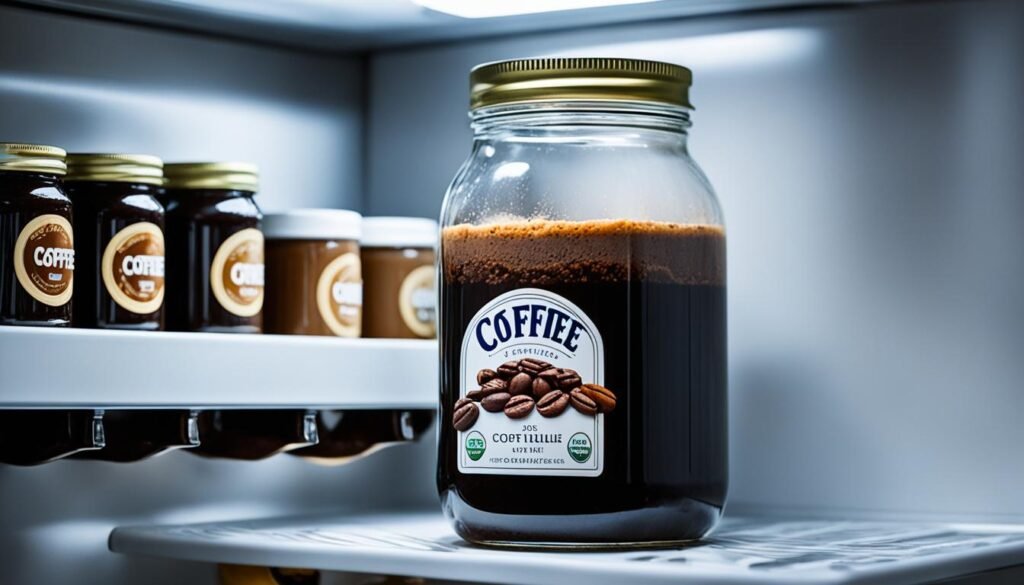Ever pondered why your homemade coffee doesn’t match the barista’s quality? The answer might lie in your measurements. I’ve often grappled with the right coffee grounds per cup, and I’m not the only one. Let’s delve into the realm of perfect coffee ratios and discover the secret to consistently great coffee.
Creating the perfect coffee begins with grasping the fundamentals. I’ve discovered that a standard coffee cup is not universally defined. Typically, it’s 6 ounces, not 8. This insight revolutionized my coffee experience. Now, I use about two tablespoons of grounds per cup, but there’s more to it than just that.
In this guide, I’ll unveil my insights on achieving that ideal coffee-to-water balance. We’ll delve into why precise measurements are crucial and how they can revolutionize your morning routine. Whether you’re a coffee beginner or a connoisseur, prepare to enhance your brew with some straightforward yet potent techniques.
Understanding Coffee Measurements
I find brewing coffee to be a fascinating process, but it requires precision. Let’s explore the intricacies of coffee measurements to craft the ideal cup.
Defining a “Cup” in Coffee Terms
In the realm of coffee, the term “cup” diverges from its common usage. It refers to a 6-ounce volume, distinct from the typical 8-ounce standard. This nuance is pivotal for achieving accurate coffee measurements. Many coffee makers are calibrated with 5-ounce increments, anticipating some water loss during the brewing process.
The Importance of Accurate Measurements
Accurate coffee measurements are essential for a consistent flavor profile. I advocate for the use of a kitchen scale for unparalleled precision. It ensures the coffee-to-water ratio is consistently achieved, resulting in a superior brew.
Coffee Scoop vs. Tablespoon
Many aficionados employ scoops or tablespoons for measuring their coffee. A standard coffee scoop is equivalent to approximately 2 tablespoons or 10-12 grams of grounds. Below is a comparative table for clarity:
| Measurement Tool | Equivalent in Grams | Equivalent in Tablespoons |
|---|---|---|
| Coffee Scoop | 10-12 grams | 2 tablespoons |
| Tablespoon | 5-6 grams | 1 tablespoon |
| Kitchen Scale | Precise to 0.1 gram | N/A |
These measurements serve as a starting point. Feel free to modify them according to your personal taste and the coffee cup size you prefer.
The Golden Ratio: Coffee-to-Water Balance
Discovering the perfect cup of coffee hinges on a single element: the coffee-to-water ratio. This ratio, often referred to as the golden ratio, is pivotal in crafting your brew. Let’s explore the realm of precision in coffee making!
The Specialty Coffee Association advocates for a golden ratio of 55 grams of coffee per liter of water. This translates to a 1:18 brewing ratio for those tracking the numbers. Yet, fear not if this seems too precise. A range between 1:15 and 1:18 is suitable for most coffee enthusiasts.
For novices, I suggest beginning with a 1:16 ratio. This means 1 gram of coffee for every 16 mL of water. It’s a versatile starting point that yields a well-balanced flavor. Feel free to tweak it as per your taste or your brewing technique.
| Ratio | Coffee (g) | Water (mL) | Strength |
|---|---|---|---|
| 1:15 | 20 | 300 | Strong |
| 1:16 | 18.75 | 300 | Balanced |
| 1:18 | 16.67 | 300 | Mild |
The golden ratio serves as a foundation, but don’t hesitate to experiment. Finding your ideal coffee balance is key. After all, the ultimate coffee experience is one that exhilarates your senses!
How Much Coffee Grounds Per Cup: Finding the Perfect Amount
Discovering the ideal coffee grounds per cup is crucial for brewing a delightful pot. I’ll navigate you through the optimal measurements for various brewing techniques. This will help you achieve coffee excellence.
Standard Drip Coffee Makers
For drip coffee, I suggest using 1 to 2 tablespoons of grounds per 6-ounce cup. This ratio ensures a balanced brew, neither too weak nor too strong. Adjust the amount based on the size of your coffee cups.
French Press Method
The French press method calls for a higher coffee-to-water ratio. I advise using 2 tablespoons of grounds for every 7 to 8 ounces of water. This method yields a richer flavor due to the extraction of more oils.
Pour-Over Technique
Begin with 1½ scoops (about 3 tablespoons) per 8 ounces of water for pour-over coffee. This technique offers precise control over brewing, allowing you to fine-tune the strength of your coffee.
| Brewing Method | Coffee Grounds | Water |
|---|---|---|
| Drip Coffee | 1-2 tablespoons | 6 oz |
| French Press | 2 tablespoons | 7-8 oz |
| Pour-Over | 3 tablespoons | 8 oz |
These guidelines are just a starting point. Feel free to tweak them based on your taste preferences and the unique characteristics of your coffee beans. Experimentation is essential to discovering your ideal cup!
Factors Affecting Coffee Strength
Several factors influence the strength and flavor of coffee when brewing. Understanding these elements can help you craft the perfect cup. Let’s delve into the key variables that shape your coffee’s taste and intensity.
Grind Size and Its Impact
The grind size is crucial for coffee strength. Finer grinds extract quickly, leading to a stronger brew. Conversely, coarser grinds produce a milder taste. It’s vital to align your grind size with your brewing method for the best results.
Roast Level Considerations
Roast level significantly impacts coffee strength. Darker roasts boast a bolder flavor, often requiring less coffee for a robust cup. Lighter roasts, however, may need more grounds to achieve the same intensity. Exploring different roast levels can help you discover your ideal balance.
Brewing Method Variations
Various brewing methods demand distinct coffee-to-water ratios and grind sizes. For instance, espresso employs a fine grind and brief extraction, whereas French press uses a coarse grind and longer steeping. Grasping these nuances is essential for excelling in different coffee styles.
| Brewing Method | Grind Size | Extraction Time | Coffee Strength |
|---|---|---|---|
| Espresso | Fine | 20-30 seconds | Strong |
| French Press | Coarse | 4-5 minutes | Medium |
| Pour-Over | Medium-Fine | 2-3 minutes | Mild to Medium |
By considering grind size, roast level, and brewing methods, you can tailor your coffee’s strength to your taste preferences. The perfect cup is a harmonious balance of these elements.
Measuring Tools for Precision Brewing
When brewing the perfect cup of coffee, precision is paramount. The right coffee measuring tools can significantly impact the outcome. Let’s delve into the essential equipment for precise coffee measurements.
A kitchen scale is my primary tool for measuring coffee grounds. It offers the most precise measurements, down to the gram. This precision ensures consistent results in every brew. For those who prefer simplicity, a coffee scoop is a viable alternative. It typically holds about two tablespoons, suitable for many brewing methods.
For espresso aficionados, a high-precision scale that measures to the tenth of a gram is advisable. Such accuracy is vital for crafting the perfect shot. Some advanced scales, like the Acaia Pearl, come with built-in timers and Bluetooth connectivity for greater control over your brew.
- Kitchen scale (measures to the gram)
- Coffee scoop (2 tablespoons)
- High-precision scale (for espresso, measures to 0.1g)
Always clean your coffee measuring tools after each use. This step prevents flavor contamination and guarantees your next brew tastes as good as the last. With these tools at your disposal, achieving coffee perfection becomes a regular occurrence.
Adjusting Coffee Dosage for Personal Taste
Finding the perfect coffee dosage is akin to discovering your favorite song. It’s a deeply personal journey that requires some trial and error. Adjusting the amount of coffee grounds can significantly impact the flavor balance and strength of your brew.
Experimenting with Ratios
Begin with the standard ratio of 1-2 tablespoons of coffee per 6 ounces of water. This is a good starting point for most coffee enthusiasts. However, feel free to experiment to tailor the dosage to your taste preferences. I recommend keeping a coffee journal to document your experiments. This will help you track the effects of different ratios on your brew.
Here’s a simple guide to assist you in finding your ideal coffee dosage:
| Desired Strength | Coffee Dosage (per 6 oz water) | Flavor Profile |
|---|---|---|
| Mild | 1 tablespoon | Subtle, light-bodied |
| Medium | 1.5 tablespoons | Balanced, smooth |
| Strong | 2 tablespoons | Bold, rich |
Balancing Flavor and Strength
Striving for the perfect flavor balance is crucial. I’ve discovered that grinding coffee beans immediately before brewing can significantly enhance the flavor. It’s important to note that different roasts and brewing methods may require adjustments to your coffee dosage. Lighter roasts generally require more grounds, whereas darker roasts can be more potent with less.
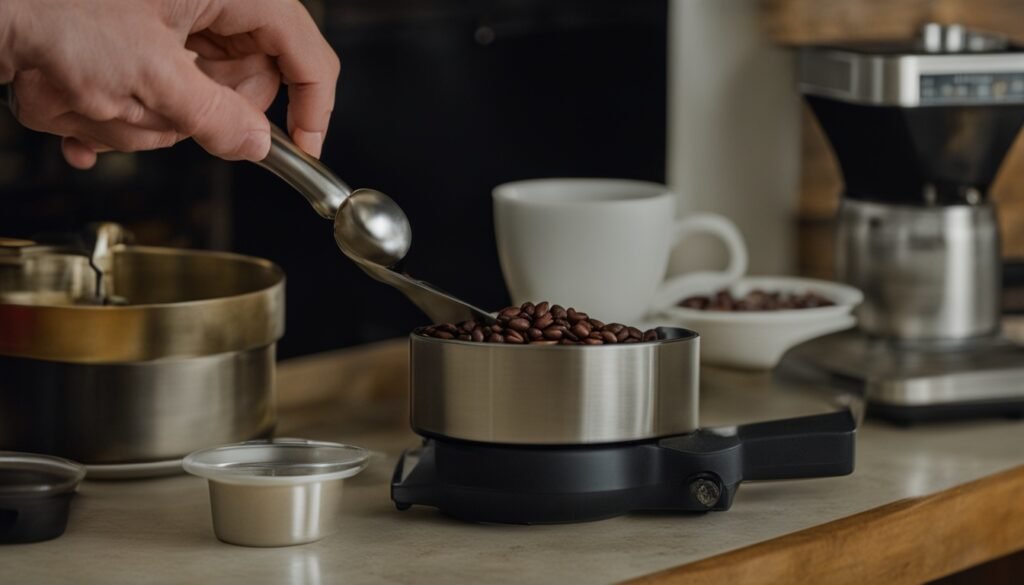
Don’t hesitate to experiment with your coffee strength. If your brew is too weak, incrementally increase the grounds. Conversely, if it’s overpowering, reduce the dosage slightly. The aim is to strike a balance where the coffee’s inherent flavors are accentuated without any overpowering bitterness or weakness.
Common Mistakes to Avoid When Measuring Coffee
Brewing the perfect cup of coffee is an art, but it’s easy to make coffee measuring mistakes. Avoiding these errors can significantly impact your coffee’s taste. Let’s delve into some common pitfalls and how to avoid them.
Over-extraction and Under-extraction
Over-extraction and under-extraction are significant issues that can mar your coffee experience. Over-extraction results in a bitter taste due to too much flavor being pulled from the grounds. Conversely, under-extraction leads to weak, sour coffee.
| Issue | Cause | Result | Solution |
|---|---|---|---|
| Over-extraction | Too fine grind, long brewing time | Bitter coffee | Use coarser grind, reduce brewing time |
| Under-extraction | Too coarse grind, short brewing time | Weak, sour coffee | Use finer grind, increase brewing time |
Inconsistent Measurements
Inconsistent measurements can yield unpredictable results. To prevent this, I always employ the same measuring method and tools. This consistency ensures a consistent flavor profile every time. It’s also beneficial to use whole beans and grind them fresh for better consistency.
Remember, reusing coffee grounds is a major mistake. It leads to bitter, over-extracted coffee. Fresh grounds are crucial for a delicious brew. By steering clear of these common coffee measuring mistakes, you’ll ensure consistently great coffee.
Conclusion
Perfect coffee brewing is an art that demands dedication and precision. Through meticulous attention to coffee measurement tips, I’ve refined my brewing skills. Achieving the ideal ratio of coffee grounds to water is paramount. It transcends mere recipe adherence, delving into the intricate interplay of variables that shape the final product.
Water quality, bean freshness, and brewing time significantly influence the outcome. Experimenting with different ratios and methods has led me to my perfect cup. The thrill of adjusting grind sizes and roast levels reveals the nuances in flavor, enriching my coffee experience.
Consistency in measurements is essential for brewing excellence. With each attempt, I refine my craft, moving closer to my ideal brew. This journey of discovery culminates in a personalized coffee experience, tailored to my preferences. Adhering to these coffee measurement tips propels me towards becoming a proficient home barista.
FAQ
What is the standard “cup” size in coffee measurements?
Traditionally, a “cup” in coffee is 6 ounces, not the typical 8-ounce size. This detail is crucial for precise brewing and consistent taste.
Why are precise measurements crucial when brewing coffee?
Precise measurements are vital for consistent flavor and strength in your coffee. Inaccurate measurements can result in over-extraction (bitterness) or under-extraction (sourness), leading to unpredictable brews.
How do coffee scoops differ from tablespoons?
A coffee scoop is roughly equal to 2 tablespoons or 10-12 grams of grounds. Using a coffee scoop ensures more consistent measurements than regular tablespoons, enhancing your brewing process.
What is the recommended coffee-to-water ratio for brewing?
The Specialty Coffee Association suggests a “Golden Ratio” of 55 grams of coffee per liter of water (1:18). Yet, a range of 1:15 to 1:18 is acceptable, with 1:16 being a versatile starting point for various brewing methods.
How do grind size and roast level affect coffee strength?
Grind size is a critical factor in extraction, with finer grinds extracting more quickly than coarser ones. Darker roasts tend to be stronger, often requiring less coffee for a robust flavor. Adjusting grind size and coffee amount can tailor the strength and taste to your liking.
What is the best tool for measuring coffee grounds?
For precise coffee measurement, a kitchen scale in grams is ideal. High-end scales like the Acaia Pearl offer superior precision, but a basic scale accurate to the nearest gram is also effective for home use.
How can I adjust coffee dosage to suit my personal taste preferences?
Begin with the recommended ratios and tweak them based on your taste. Add more coffee for a stronger brew or less for a lighter flavor. Consider the coffee’s origin, roast, and brewing method when adjusting. Experiment and keep track of your changes to discover your perfect brew.
What are common mistakes to avoid when measuring coffee?
Avoid over-extraction (bitterness) from too fine a grind or excessive brewing time, and under-extraction (sourness) from too coarse a grind or insufficient brewing time. Also, inconsistent measurements can lead to unpredictable results.
Source Links
- https://www.drivencoffee.com/blog/perfectly-brewed-how-many-scoops-of-coffee-do-you-need/
- https://counterculturecoffee.com/blogs/counter-culture-coffee/coffee-basics-brewing-ratios?srsltid=AfmBOopkasYLDv7FkpoURhJss7QjEyD5fWgktu86xhVhehgZiGq7wvMb
- https://www.ncausa.org/About-Coffee/How-to-Brew-Coffee





